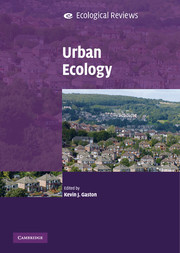Book contents
- Frontmatter
- Contents
- List of contributors
- Preface
- 1 Urban ecology
- 2 Urbanisation
- 3 Urban environments and ecosystem functions
- 4 Individual species and urbanisation
- 5 Species diversity and urbanisation: patterns, drivers and implications
- 6 Urbanisation and alien invasion
- 7 Interactions between people and nature in urban environments
- 8 Urban ecology and human social organisation
- 9 Urban ecology and human health and wellbeing
- 10 Bringing cities alive: the importance of urban green spaces for people and biodiversity
- 11 Integrating nature values in urban planning and design
- 12 Urban futures
- Index
- References
8 - Urban ecology and human social organisation
Published online by Cambridge University Press: 05 June 2012
- Frontmatter
- Contents
- List of contributors
- Preface
- 1 Urban ecology
- 2 Urbanisation
- 3 Urban environments and ecosystem functions
- 4 Individual species and urbanisation
- 5 Species diversity and urbanisation: patterns, drivers and implications
- 6 Urbanisation and alien invasion
- 7 Interactions between people and nature in urban environments
- 8 Urban ecology and human social organisation
- 9 Urban ecology and human health and wellbeing
- 10 Bringing cities alive: the importance of urban green spaces for people and biodiversity
- 11 Integrating nature values in urban planning and design
- 12 Urban futures
- Index
- References
Summary
Introduction
Consider a tree, growing in a forest. Its fate, in terms of growth rate, longevity and reproduction, is regulated by a suite of biotic and abiotic factors, such as soil moisture, competition with other plants and interactions with natural enemies. Its branches, leaves and roots contribute to nutrient and water cycles. The tree provides habitat for animals – insects, birds, mammals. Understanding these interactions falls squarely in the domain of classical ecology. Now, imagine that the tree and its surrounding forest is part of a city, the trees interspersed with houses, streets, lawns and gardens. Here, the fate of the tree becomes strongly intertwined with the lives and decisions of humans. Its longevity, reproductive rate and contributions to the larger ecosystem are mediated by a complex suite of anthropogenic processes. In this setting, the tree's life cycle may differ from that of all of its ancestors: its ‘birth’ perhaps in a commercial nursery, its dispersal through an economic system of marketing and transportation, its growth determined by local application of fertiliser by a resident or a lawn care firm, its ultimate removal (death/decay) perhaps mediated by city policies on tree hazards, its reproduction quelled entirely. Yet, the tree and its urban forest still contribute to ecosystem processes. It provides habitat for animals, and its leaves, branches and roots still influence the flow of water through the urban ecosystem. Humans, therefore, both consciously and unconsciously sculpt biodiversity and ecosystem functioning in cities (and elsewhere).
- Type
- Chapter
- Information
- Urban Ecology , pp. 172 - 201Publisher: Cambridge University PressPrint publication year: 2010
References
- 11
- Cited by



